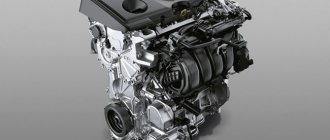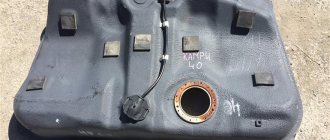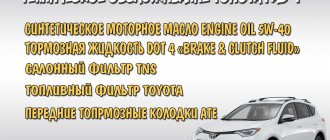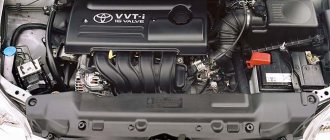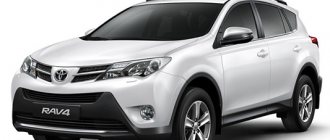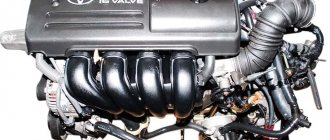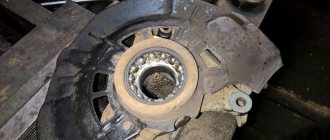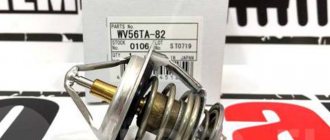Japanese automakers have always been famous for their reliable and economical engines. Motors produced several decades ago are still in successful use today, delighting car owners with reliability and excellent technical characteristics. The 3S FE four-cylinder petrol engine from Toyota is very popular.
This two-liter injection engine appeared in 1986 and, with minimal changes, remained on the assembly line until 2000.
Specifications
By default, the characteristics of the Toyota 3S FE series engine are as follows:
| Manufacturer | Kamigo Plant (Japan) and TMMK (USA) |
| Engine brand | Toyota 3S-FE |
| Years of production | 1986 – 2001 |
| Volume | 1998 cm3 |
| Power | 98 – 116 kW (131 – 155 hp) |
| Torque | 183 Nm (4400 – 4800 rpm), 186 Nm (4400 – 5200 rpm) |
| Weight | 140 kg |
| Compression ratio | 9,8 |
| Nutrition | injector |
| Motor type | in-line |
| Injection | electronic multipoint |
| Number of cylinders | 4 |
| Location of the first cylinder | TVE |
| Number of valves on each cylinder | 4 |
| Cylinder head material | aluminum alloy |
| Allowable warpage | manifold gaskets (intake/exhaust) 0.08 mm cylinder head gasket 0.05 mm |
| Valve seat | width 1 – 1.4 mm, angle 45° |
| Camshaft | quantity – 2 pieces pusher with a diameter of 30.966 – 30976 mm boring for pusher 31.00 – 31.025 mm |
| Camshaft oil seal | diameters – 38 mm, 50 mm, width 8 mm |
| Cylinder block material | cast iron |
| Cylinder diameter | 1 standard size – 86 – 86.01 mm Size 2 – 86.01 – 86.02 mm Size 3 – 86.02 – 86.03 mm |
| Pistons and rings | |
| Piston diameter | 1 standard size –85.837 – 85.847 mm Size 2 – 85.847 – 85.857 mm 3 standard size – 85.857 – 85.867 mm re-size – 86.337 – 86.367 mm |
| Gaps | piston/cylinder wall – 0.153 – 0.173 mm (standard) or 0.19 mm (maximum) piston rings – 110 mm relative to the cut plane |
| Upper compression ring | 0.27 – 0.47 mm |
| Lower compression ring | 0.45 – 0.65 mm |
| Oil scraper ring | 0.1 – 0.45 mm, 1.05 mm maximum |
| Gap between piston groove and ring | 0.03 – 0.07 mm |
| Crankshaft | |
| Number of main bearings | 5 |
| Gearbox neck diameter | 54.988 – 55.003 mm |
| Main journal gap | 0.015 – 0.034 mm |
| Connecting rod bearings | shaft journal diameter – 48 mm bed diameter – 51 mm liner thickness – 1.448 mm liner width – 20.4 mm |
| Crankshaft oil seals | front – diameters 42 mm, 60 mm, width 7 mm rear – diameters 85 mm, 105 mm, width 10 mm |
| Piston stroke | 86 mm |
| Fuel | AI-95 (AI-92 allowed) |
| Motor weight | 143 kg assembled |
| Environmental standards | Euro 4 |
| Fuel consumption | highway – 8 l/100 km combined cycle 9.5 l/100 km city – 13 l/100 km |
| Oil consumption | maximum 1 l/1000 km |
| Engine oil for 3S FE | 5W-30 and 10W-30 |
| Engine oil volume | 4.5 l |
| Replacement frequency | every 5000 km, maximum 10000 km |
| Working temperature | 95° |
| Motor life | declared 300,000 km actual 500,000 km |
| Adjustment of valves | washers between camshaft cams and tappets |
| Cooling system | forced, antifreeze/antifreeze |
| Coolant quantity | AT – 5.7 l, MT – 5.8 l |
| Spark plugs for 3S FE | original – NGK BKR6E11, Denso K20RU11, NGK BKR6EYA11, you can install any suitable size with two electrodes |
| Gap between spark plug electrodes | 1.1 mm |
| Timing belt | 163 teeth, pitch 8 mm, belt width 26.7 mm |
| Cylinder operating order | 1-3-4-2 |
| Air filter | Nitto, Knecht, Fram, WIX, Hengst |
| Oil filter | catalog number 90915-10001 replacement 90915-10003, with check valve |
| Flywheel | internal hole diameter – 42 mm diameter of mounting holes – 13 mm number of mounting holes – 8 pieces no offsets distance between opposite mounting holes – 54 mm distances between adjacent mounting holes – 12 mm |
| Flywheel mounting bolts | box MT – M10x1.25 mm, length 26 mm, groove 11 mm box AT – M10x1.25 mm, length 26 mm without groove |
| Valve stem seals | code 90913-02090 inlet light code 90913-02088 exhaust dark |
| Compression | pressure in cylinders from 13 bar nominal, 9.5 bar minimum, pressure difference in individual cylinders within 1 bar |
| Oil temperature | 80°С |
| Thermostat temperature | 80 – 84°С |
| Valve pressure inside the radiator cap | 0.7 – 1 bar |
| Content of harmful products in the exhaust | CH <200%, CO <0.5% |
| XX speed | 650 – 750 min-1 |
| Tightening force of threaded connections | spark plug – 18 Nm flywheel – 88 Nm clutch bolt – 19 Nm bearing cap – 59 Nm (main) and 25 + 90° (rod) cylinder head – three stages 29 Nm, 49 Nm and 90° |
A special feature of the engine is that even if the timing belt breaks, it does not bend the valve. The resource in practice is significantly higher than that stated by the manufacturer in the manual.
ICE design
Decoding of internal combustion engine markings
In Russia, GOST R53638 is used to create an engine code. All manufacturers of such units are required to label their products in accordance with State regulations.
Each country has its own engine labeling system. The Japanese marking system, using the 3S-FE engine as an example, looks like this: 3S FE DOHC16V 2.0.
The designation is deciphered as follows:
- 3 - design change in the S line of engines;
- S - series of internal combustion engines with in-line cylinders and multiple fuel injection;
- F - means that there are 4 valves for each cylinder;
- E — electronic injection system EFI;
- DOHC - the unit has 2 camshafts, the 1st camshaft is driven by a belt, the 2nd camshaft is driven by the 1st camshaft gear;
- 16V — hydraulic gap compensation;
- 2.0 - engine volume in liters.
If the engine code contains one letter after the first digit, this means that the engine was manufactured before 1991.
Design features of 3S-FE:
- The pump (pump for circulating coolant) is installed in the cylinder block and secured with bolts. The pump is driven by a belt.
- Crankshaft made of cast iron. Its axial play is adjusted by special thrust semicircular washers inside the main middle bearing. The backlash adjustment is done in accordance with the official manual (instructions).
- Due to the fact that the 3C-FE engine was invented in the 1980s, it does not require very high quality fuel. Usually AI-92 is used.
- For engines produced before 1996, the recommended oil was 5w-40. For engines after 1996 - 5w-30.
- The design of the valve assembly was not convenient. To adjust the valves, you will have to remove the shafts, which will throw off the phase settings and, by selecting washers according to thickness, set the required gaps.
- It is impossible to remove the intake manifold separately with your own hands without removing the cylinder head.
- The intake manifold has a protective thermal shield.
There are some inconveniences during its repair and maintenance, but the 3S-FE engine is reliable and more economical than the 3S carburetor modification.
Description of the 3S FE motor
With the advent of distributed electronic injection, a version of the 3S FE injection engine was developed. The design of the 3S engine was so reliable that its modification was installed “on everything that drives,” that is, on almost all Toyota models from 1997 to 2001. releases.
Cooling system
By default, S3 and all its modifications are “million-dollar” engines with a corresponding mileage resource.
Drive attachments from one timing belt
Explanation of markings
In the Russian Federation, motor designations are regulated by the domestic standard GOST R53638. Western and Asian manufacturers use their own markings, and Nissan and Toyota have the most informative markings, so the Japanese 3S FE DOHC16V 2.0 engine is deciphered as follows:
- 3 – design solution of the internal combustion engine, in this case the volume is about 2 liters;
- S – a series of engines with in-line cylinders and multiple fuel injection;
- F – 4 valves on each cylinder;
- E – EFI injection system (electronic type);
- DOHC – two camshafts as a drive, rotation is transmitted to one of them from the crankshaft by a timing belt, to the second by a gear from the previous camshaft;
- 16 V – hydraulic gap compensation;
- 2.0 – internal combustion engine volume.
Engine cylinder block
A series with one letter index after the first digit indicates that the internal combustion engine was developed before 1990. The main design features of this type of internal combustion engine are:
- the pump is bolted to the cylinder block and rotates by a belt drive;
- the axial play of the cast iron crankshaft is adjusted by thrust semicircular washers inside the main bearing (middle), the adjustment procedure is contained in the official manual;
- the system was designed before 1990, that is, according to old safety standards, it can be operated on AI-92 gasoline;
- Initially, the manufacturer recommended the use of 5W50 oil; after 1996, Toyota cars came off the factory assembly line with 5W30 lubricant;
- the design of the valve drives was not fully developed by the designers from the beginning; to adjust the clearance parameters, you will have to pull out the shafts, throwing off the phase settings, select washers according to their thickness, and assemble the components in the reverse order;
- it is physically impossible to dismantle the intake manifold separately from the cylinder head;
- the exhaust manifold is protected by a thermal shield
Lubrication system
Exhaust manifold
Otherwise, the design of the 3S-FE engine is quite reliable; it is considered more economical in comparison with the previous 3S carburetor engine.
Reliability, weaknesses, maintainability
Reviews about the reliability of 3C engines vary. The 3C series is more reliable than the previous modifications 1C and 2C. 3c engines have excellent power ratings of 94 horsepower. Thanks to the high torque, cars with the 3C engine installed are distinguished by excellent dynamic characteristics and provide excellent acceleration of the car.
The engines are equipped with a starting aid system, a turbine, and throttle valve adjustment.
However, there are some weak points. 3C engines have earned the reputation of being the strangest and most illogical power units in the entire history of Toyota cars over the last 20 years. Experienced users of Toyota cars note the following negative aspects of engine design:
- lack of balancing shaft;
- unreliable oil pump;
- failure to comply with environmental standards;
- destruction of the gas distribution mechanism drive belt due to failure to meet replacement deadlines.
As a result of a belt rupture, catastrophic consequences occur for the owner of a Toyota car. The valves bend, the camshaft breaks, and cracks appear in the valve guides. Repairs after such an event are very long and expensive. To avoid belt rupture, the owner should carefully monitor the engine belt drives, observing the timing of their replacement.
The maintainability of these engines is satisfactory. The latest versions of engines are equipped with an electronically controlled injection pump. It allowed:
- reduce fuel consumption;
- significantly reduce exhaust toxicity;
- ensure smooth, uniform, quiet operation of the unit.
At the same time, there are also disadvantages. The vast majority of domestic services are not staffed with professional specialists for repair, adjustment, and maintenance of such fuel injection pumps. There is no diagnostic equipment, necessary components, or repair facilities. As a result, the overall maintainability of Toyota cars suffers.
What cars is it used in?
By default, the 3S FE engine was installed on the following Toyota car models:
- Caldina – 1st and 2nd generation, station wagon;
- Camry – 2nd – 4th generation, sedan body;
- Carina – 6th and 7th generation, sedan body;
- Carina ED – 2nd and 3rd generation, sedan body;
- Celica – 5th and 6th generation, coupe body;
- Corona – 8th generation coupe, 9th generation sedan and hatchback, 10th generation sedan and hatchback;
- Corona Exiv – 1st and 2nd generation, sedan body;
- Corona Premio – 1st generation, sedan body;
- Curren – 1st generation, coupe body;
- Gaia – 1st generation, minivan body;
- Ipsum – 1st generation, minivan body;
- Lite Ace Noah – 1st generation, minivan body;
- Nadia – 1st generation, minivan body;
- Picnic – 1st generation, minivan body;
- RAV4 – 1st generation, open body and SUV (Japan, USA);
- Town Ace Noah – 5th generation, minivan body;
- Vista – 3rd – 5th generation, sedan body;
- Vista Adreo – 1st generation, station wagon.
3SFE engine in Toyota RAV-4
In the Lite Ace Noah and Town Ace Noah minivans, the internal combustion engine is located longitudinally. The flywheel is 10 mm larger in diameter and is located on the side opposite the starter. During repairs, you will have to grind it down with your own hands and rearrange the crown from the gearbox flywheel.
Maintenance schedule
To ensure maximum service life, especially on machines manufactured after 1996, the manufacturer recommends that you follow the maintenance regulations, since major repairs are impossible for them. The table shows the frequency of replacement of consumables:
| Maintenance object | Time or mileage (whichever comes first) |
| Timing belt | replacement after 100,000 km |
| Battery | 1 year/20000 |
| Valve clearance | 2 years/20000 |
| Crankcase ventilation | 2 years/20000 |
| Belts that drive attachments | 2 years/20000 |
| Fuel line and tank cap | 2 years/40000 |
| Motor oil | 1 year/10000 |
| Oil filter | 1 year/10000 |
| Air filter | 1 – 2 years/40000 |
| Fuel filter | 4 years/40000 |
| Heating/Cooling Fittings and Hoses | 2 years/40000 |
| Coolant | 2 years/40000 |
| Oxygen sensor | 100000 |
| Spark plug | 1 – 2 years/20000 |
| Exhaust manifold | 1 year |
Each Toyota model has a manual containing a description of what oil and coolant to use.
Main breakdowns and ways to fix them
Typical malfunctions for the 3S-FE engine, without taking into account the sensors and regulators of the on-board ECU system that can be attached to it, are:
| Malfunction | Cause | Elimination |
| Speed misadjustment XX | coke on the walls of the intake manifold, reducing combustion chamber volumes dirt on the throttle valve | cleaning the valve and manifold |
| fuel pump failure | fuel pump repair | |
| clogged air filter | replacing the air filter | |
| Floating speed | EGR valve failure | cleaning or replacing the valve |
| Progressive Vibrations | problem in the engine airbag one cylinder does not work | airbag inspection, engine diagnostics |
| Increased fuel consumption | the ignition is broken; XX valve adjustment is broken ; dirt in injectors | adjusting the ignition and idle air valve, cleaning the injectors |
Engine repair
"Top" of the most powerful three-cylinder engines.
Three-cylinder car engines, as a rule, have few capabilities and, of course, first of all, their characteristics are similar to motorcycle engines. But not all three-cylinder power units are so boring. In the auto world there are many three-cylinder engines that deserve attention and respect. And so, we open our “top”:
